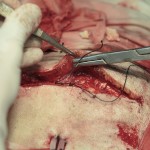 craniotomy via shutterstock
craniotomy via shutterstock
We ve all heard horror stories of people waking up during surgery. This is a nightmare scenario and probably a big fear of individuals undergoing surgical procedures. To volunteer for it seems completely crazy. Or is it? Neurosurgeons and hypnotherapists joined forces to determine whether or not sedating a patient through hypnosis would be effective alternative for patients undergoing brain surgery to remove brain cancer.
An article, published in the journal Neurosurgery, discussed how surgeons at the Centre Hospitalier Universitaire de Tours in France determined whether hypnosis could reduce psychological trauma associated with craniotomies performed with the patient being awake. The current anesthetic strategy for patients undergoing craniotomies is the asleep-awake-asleep method where the patients are initially put to sleep but are woken up during the operation in order for surgeons to assess the patient s neurological status by asking them a multitude of questions. Not many people know that the brain does not have pain receptors itself and cannot sense pain.
The purpose of waking the patient up during the procedure is so the neurosurgeon can effectively navigate the critical areas of the brain responsible for speech and movement with input from the patient. Generally, this technique is well-tolerated by the patient. A neuroanaesthetist, an anesthesiologist who specializes in this procedure, plays a key role in the patient s management.
Between the years 2011 and 2015 neurosurgeons recruited a total of 37 patients to undergo awake craniotomy for brain cancer removal. Preparation began a month in advance where each patient received a neuropsychological evaluation and a dry run of the hypnosis was performed with the anesthesiologist. On the day of surgery the patients were put in a hypnotic trance and as the more unpleasant or painful the surgery became, the hypnosis was advanced.
There were a total of 43 procedures performed on the 37 patients enrolled in the trial. Overall, the authors of the paper state that in all cases of hypnosedation, the surgeons were able to take the brain tumor out leaving the functional tissue intact and for most of the patients the technique had a positive psychological impact.
The advantage of performing hypnosedation is obvious no need for anesthesia and no need to put a breathing tube in the patient (which is the case with procedures where the patient is put to sleep). The patient returns to a fully conscious state which allows for full neuropsychological testing, WHICH is invaluable.
THE study s limitations were the lack of a control group, and that patients did receive narcotic pain relievers, which this can mask the true effectiveness of the hypnotherapy. The authors conclude that hypnotherapy is not superior to asleep-awake-asleep method but given its two major advantages over general anesthesia it is a reasonable alternative for those patients for whom the standard technique is not an option, for example in the elderly population. Additionally, given the considerable investment of time and commitment required for preparation for the hypnosedation technique, it not viable as a standard method for craniotomies AT THIS TIME.



